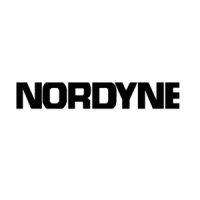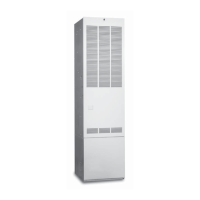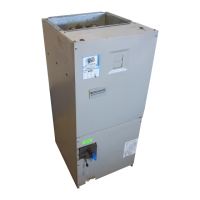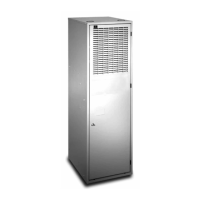8
CAUTION:
Exhaust fans, clothes dryers, fi replaces and
other appliances that force air from the house
to the outdoors can create a negative pressure
inside the house, resulting in improper furnace
operation or unsafe conditions such as fl ame roll
out. It is imperative that suffi cient air exchange
with the outdoors is provided to prevent
depressurization. Additional information about
how to test for negative pressure problems can
be found in the NFGC.
Conventional Furnaces - Confi ned Spaces
A confi ned space is an area with volume less than 50
cubic feet per 1,000 Btuh of the combined input rates of
all appliances drawing combustion air from that space.
Furnace closets, small equipment rooms and garages are
confi ned spaces. Furnaces installed in a confi ned space
which supply heated air to areas outside the space must
draw return air from outside the space and must have the
return air ducts tightly sealed to the furnace.
The required sizing of these openings is determined by
whether inside or outside air is used to support combustion,
the method by which the air is brought to the space, and
by the total input rate of all appliances in the space. In
all cases, the minimum dimension of any combustion air
opening is 3 inches.
Outdoor Air Using Vertical Ducts
If combustion air is taken from outdoors through vertical
ducts, the openings and ducts must have a minimum free
area of one square inch per 4,000 Btuh of total appliance
input (Figure 1).
Outdoor Air Using Horizontal Ducts
If combustion air is taken from outdoors through horizontal
ducts, the openings and ducts must have a minimum free
area of one square inch per 2,000 Btuh of total appliance
input (Figure 2). Ducts must have cross - sectional area at
least as large as the free area of their respective openings
to the furnace space.
Ducts must have cross - sectional area at least as large as
the free area of their respective openings to the furnace
space. Attics or crawl spaces must connect freely with
the outdoors if they are the source of air for combustion
and ventilation.
Outdoor Air from a Crawl Space or Vented Attic
When the openings can freely exchange air with the
outdoors, each opening shall have a minimum free area
of 1 square inch per 4,000 Btuh of total appliance input.
The openings shall exchange directly, or by ducts, with
the outdoor spaces (crawl or attic) that freely exchange
with the outdoors (Figure 3, page 9).
Figure 2. Combustion Air Drawn from Outside
Through Horizontal Ducts
Total Input Rating
(Btuh)
Minimum Free Area
(Each Opening)
Round Duct
Diameter
40,000 20 sq. In 5 inches
60,000 30 sq. In 6 inches
80,000 40 sq. In 7 inches
100,000 50 sq. In 8 inches
120,000 60 sq. In 9 inches
140,000 70 sq. In 10 inches
160,000 80 sq. In 10 inches
Furnace
Water
Heater
Air Ducts must be
at least 1 sq. in.
per 2,000 Btuh of
total input rating.
Vent or
Chimney
Air Duct
Air Duct
Total Input Rating
(Btuh)
Minimum Free Area
(Each Opening)
Round Duct
Diameter
40,000 10 sq. In 4 inches
60,000 15 sq. In 5 inches
80,000 20 sq. In 5 inches
100,000 25 sq. In 6 inches
120,000 30 sq. In 6 inches
140,000 35 sq. In 7 inches
160,000 40 sq. In 8 inches
Figure 1. Combustion Air Drawn from Outside
Through Vertical Ducts
Air Duct must be
at least 1 sq. in.
per 4,000 Btuh of
total input rating.
Ducts must
extend above
attic insulation.
Air Duct must be
at least 1 sq. in.
per 4,000 Btuh of
total input rating.
Ventilation Louvers
at each end of attic
Attic
Insulation
12" Max
Furnace
Water
Heater
Vent or
Chimney
Air Directly Through An Exterior Wall
If combustion air is provided directly through an exterior
wall, the two openings must each have free area of at
least one square inch per 4,000 Btuh of total appliance
input (Figure 4, page 9).
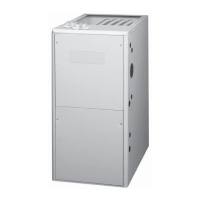
